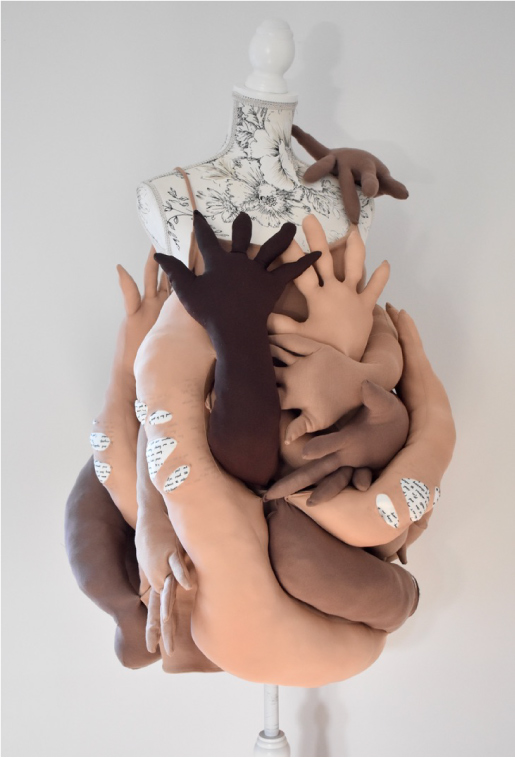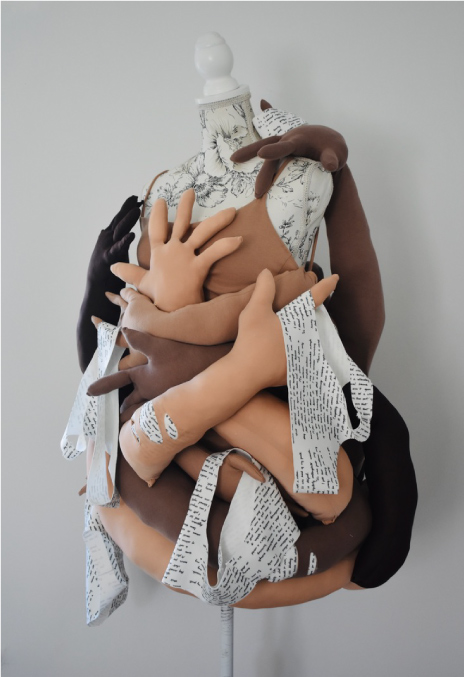
© Courtesy of Izzy Jackson
An interview with Izzy Jackson on her portrayal of sexual harassment through art and fashion.
Sexual assault is a subject which is treated as taboo and is marginalised as a result. In the year ending March 2020, 1.6 million adults (aged 16-74) had experienced sexual assault. Figures such as these can’t just simply be swept under the rug and so it is increasingly important that more voices are heard by those campaigning to spread awareness regarding sexual assault; we interviewed Oxford Brookes student, Izzy Jackson, on her recent project exploring the subject.
Could you tell us a little bit about yourself?
At A-Level I studied textiles and art which were definitely my favourite subjects and I applied to study an art foundation at Oxford Brookes which is what I have just completed this year. The tutors were really lovely, and I feel like the Oxford Brookes has a good reputation for its foundation course which is what prompted me to apply.
I was really unsure what I wanted to do after A-Level and so I wanted to do an art foundation to figure out what path I wanted to take post-school. I paint and am very interested in costume design too and I felt that the foundation would help me to choose; fashion design is what I would say I have found that I am most interested in and so in September I am going on to study fashion design at Kingston University.
What inspired you to explore sexual assault in your Final Major Project?
At the point where we were researching and deciding on a topic for our FMP, the Sarah Everard case was extremely prevalent in the media and I can remember how a social media storm had erupted about it. But with most things, it left as quickly as it came, and it made me realise that [sexual assault] is a massive issue that isn’t talked about enough. Like most, feminism in general is a topic that I am interested in and support; I wanted to create a final piece that I was passionate about, but one that I could also use to educate myself and others through because I found out so much that I didn’t know before.
I haven’t necessarily created any projects that have a political or social agenda in my previous work- as I believe it can be extremely draining- but I felt passionate about this topic in particular and felt that it was something that I wanted to engage with and create a response to in order to spread awareness.
© Courtesy of Izzy Jackson
Would you say that you were inspired to centre your project around sexual assault as a response to any personal experience, or was it more that you wanted to spread awareness around the subject?
I think it’s a bit of both really; everyone has experienced cat-calling and ‘smaller’ things like that but it’s the fact that it is normalised that I think should be challenged. I feel like as a society, it has been silenced and swept under the rug, resulting in an attitude emerging that encourages us to just ‘deal with it’.

© Courtesy of Izzy Jackson
Did you have any beliefs or views on the notion of ‘gendered clothing’ and societal norms on gender prior to researching for your FMP?
Yes definitely! There’s an apparent stigma around the whole subject. I initially looked into men’s clothing and how constrictive it has become, especially in comparison to women. I researched Billy Porter- an icon, I love him- and Harry Styles who really reinforce the message that you can wear whatever you want. I really don’t understand how we have got to this point- it is really just societal pressure that has assigned genders to clothing and this idea that has been generated has resulted in individuals not being able to wear what they want because it would be ‘wrong’. When you look back at fashion history, skirts and heels were originally created for men and I don’t understand what has made it change. I was really interested to see what others thought about this and so I included the question- ‘Do you think clothing has gender?’- and to my surprise 70% believed that it does not. Although my final piece didn’t include this research, it was really interesting to find out about other societal issues surrounding gender.

© Courtesy of Izzy Jackson
Were there any resources that you came across in your research that you were shocked by?
I read one book- Invisible Women- which was really interesting, despite its focus on statistics. The whole book focuses on how the world is designed for men and brings up examples such as how only male crash test dummies are used in crash tests for cars, meaning that there are more fatalities for women in car crashes as a result of insufficient testing for a woman’s more typically petite frame. Facts like this were really eye-opening to me and it made me reflect on how we have all become so blind to these issues that are taken as normal in our society.
I used several different sources to inspire my project, including song lyrics, books, questionnaires and more which I feel helped me get a thorough understanding of the subject matter.
Could you tell us more about your final piece?
In my development stage, I made a design constructed of balloons which was visually inspired by Iris Van Herpen and Fredrik Tjarandsen; my final piece I was heavily inspired by this developmental stage. There are several websites available whereby individuals share their stories of sexual assault and I used these platforms and stories to inspire the many developmental pieces I created that can be seen on my blog. One story in particular, where a guy described his sexual assault experience as ‘being used as a sex doll’, was really impactful and shocking; the term ‘sex doll’ appeared in several of the stories and I instantly associated it with the inflatable sex dolls which is what inspired me to use balloons in this experimental piece. The black balloons used were supposed to evoke this idea of limbs entangling with one another, consuming the body. As balloons wouldn’t last, this design was developed to create a more three-dimensional piece that would be a more long-lasting design.
The handwritten fabric included in the design were a mixture of song lyrics, responses to my questionnaire, individuals’ personal stories and books that I printed. The small handwriting intends to represent how small women’s voices are in their fight against sexual assault and how often they are unheard in society. These were incorporated into the design through the slashes of the fabric limbs which serve to represent the physical trauma that sexual assault victims will experience.


© Courtesy of Izzy Jackson
Were there any other designers that you were inspired by throughout your project?
Esmay Wagemans- who creates moulds and casts from bodies out of latex- was an inspiration! In one of her earlier projects, she was testing the nudity boundaries on Instagram by wearing these latex moulds that looked just like skin.
Alice Kay Waller is an artist that I found through TikTok who is based in a small town in America and creates body castings of women who have been sexually assaulted. I really loved her work as I think it creates such a powerful message for those who have been victimised by spreading awareness.
I found it really difficult to find artists that represented sexual assault in their work and I couldn’t find any fashion designers, so I used whatever I could find to inspire a final response. I think it is because the subject is still so taboo that it isn’t explored that widely by fashion designers and artists, which I feel motivated more to create an engaging response for my project exploring the subject.
There are many resources available for those affected by any of the subjects discussed in this interview such as NHS Sexual Assault Referral Centres and Rights of Women. It’s important for all to be able to talk to someone about their experiences, and whilst it is scary, there are safe spaces that can allow you to grow from your trauma.





コメント